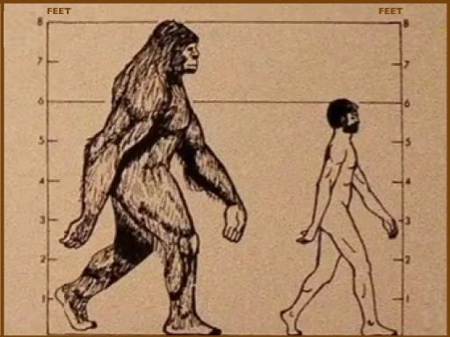Last updated on July 8th, 2022 at 10:46 am
It purportedly walks upright on feet with five digits and screams “like a woman”; however, this creature is no human. Though it rejects the romantic notion of a long-surviving proto-human, the wood ape is nonetheless the reality that we are left with after examining centuries of evidence. Bigfoot is an animal; the sasquatch is bestial.
During the 1800s newspapers were rife with reports of “Wildmen.” This moniker was given to any and all renditions of hairy—not just hair-covered—bipeds roaming the forests of North America. To jump to the conclusion that every “Wildman” report is sasquatch-related, however, is to ignore the tendency to generalize, stereotype, and outright fabricate stories by the mass media of the time. Decades of folklore passed down by European ancestors raised on tales of the Woodwose (a popular character in European culture) could certainly help account for human characteristics in early wood ape reports.
Occasionally, historical reports of “hair covered” beings with traits that ring true to modern wood ape reports do creep up. They mention creatures “lightning fast” and “hairy from head to toe.” They are seen leaping from trees, running behind farms with dead livestock, and behaving elusively.
During the early 1900s “Wildman” was replaced by the term “ape” in the media. Though these reports are few, newspapers did often report on “giant apes” seen in the vestiges of an expanding America. The behavior patterns remain the same as the apes continue to reject interaction and cling to a shrinking forest habitat.
Outside of newspapers, sightings within modern databases frequently refer to ape-like characteristics and physical attributes. Rarely do sightings of giant, upright creatures call to mind human traits. When asked about his reasoning for his use of the “wood ape” terminology, NAWAC Board of Directors member Brian Brown, and host of the popular podcast The Bigfoot Show, said, “Primarily, they live in wooded habitat and behaviorally act similar to apes.”
A common counter to the ape hypothesis is that these creatures are some remaining form of proto-human. “Homo sapiens is known to have very little body hair, and to have made tools, fire, etc.,” says NAWAC member, Stanislaus National Forest Archaeologist, and author of Giants, Cannibals, & Monsters: Bigfoot in Native Culture, Kathy Strain. “Nothing I’ve seen indicates that wood apes have any of these behaviors or skills.”
The question commonly comes up: “Why an ape”? Why does the North American Wood Ape Conservancy insist on using the term “ape”? After all, no type specimen has been produced to definitively state that this creature is not a surviving Homo neandertalensis, or even, dare I say with tongue planted firmly in cheek, a space alien.
“What we do have… are consistently observed ape behaviors,” says NAWAC member, Brown’s co-host of The Bigfoot Show, Sam Rich. “Using rocks as a mortar to crack nuts, bluff charges, ape-type vocalizations have all been observed in Area X and other locations.”
In the 1930s a rash of “ape” sightings took place in southern Ohio. The reports consistently referred to a creature, seven to eight feet tall, covered in hair, which smelled to high heaven and fled at the sight of men. Is it possible that some hapless reporter in 1933 got right something that, even today, people struggle with?
Examine the existing evidence. Weigh the good against the bad; what you’re left with is a mountain of evidence in favor of a “wood ape” and virtually nothing that stands in favor of a human being, or any of the more outlandish theories.

Other relevant articles on the NAWAC website:
Ape Appelations by Alton Higgins and Daryl Colyer (2013)
New Name, Same Mission by Brian Brown (2013)
